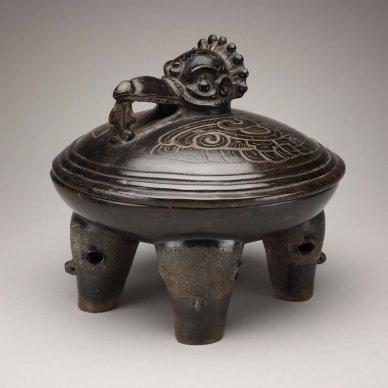
Object Title
Covered Vessel with the Principal Bird and Peccary Heads
Measurements
24.8 x 25.4 cm (9 3/4 x 10 in.)
Creation Date
A.D. 250/450
Credit Line
Joanne M. and Clarence E. Spanjer and African and Amerindian Curator’s Discretionary funds; O. Renard Goltra and National Docent Symposium endowments; African and Amerindian Art Purchase Fund; David Soltker and Irving Dobkin endowments
Museum Name
Culture
Country of Origin
Object Type
Materials / Techniques
Object URL
http://www.artic.edu/aic/collections/artwork/195461
Provenance Information
Louisiana Gallery (Joan Crystal), Houston, Texas, by mid-/late 1970s, probably before 1977; sold to Balene McCormick, Houston, Texas, then Santa Fe, New Mexico, mid-/late 1970s, probably 1977; sold to Robert and Marianne Huber Fine Arts (Huber Primitive Art), Dixon, Illinois and New York, New York, after 1977; sold to the Art Institute of Chicago, Chicago Illinois, 2008.
Exhibition Information
None
Publication Information
Elizabeth Irene Pope, "Vessel with Bird and Peccary Heads," Notable Acquisitions at the Art Institute of Chicago, Museum Studies 35, 2 (2009), pp. 6-7.
Section of the AAMD Guidelines relied upon for the exception to 1970
Informed judgement that works were outside of the country of modern discovery before 1970
Explain why the object fits the exception set forth above
Based on the results of provenance research, the Art Institute of Chicago can make an informed judgment that the object was outside its probable country of modern discovery before 1970. The Art Institute of Chicago acquired this object in 2008 from Robert and Marianne Huber Fine Arts (Huber Primitive Art), Dixon, Illinois and New York, New York. According to a letter from Marianne Huber to the curator, the object was previously owned by Balene McCormick, a collector who purchased it in or around 1977 from the Louisiana Gallery in Houston, Texas. The Louisiana Gallery acquired the object in the mid to late 1970's, but likely before 1977. Attempts to contact the Louisiana Gallery were unsuccessful, as the gallery is no longer in business. The acquisition furthers the representation of the artistic achievements of all civilizations in art museums because the object represents another form of Maya ceramic art and illustrates another aspect of mythological and kingship iconography from the two important Maya vases already in the Art Institute of Chicago’s collection.